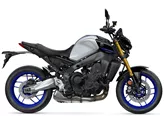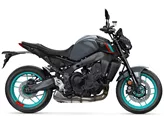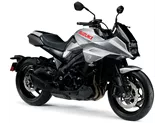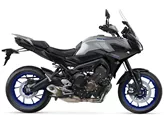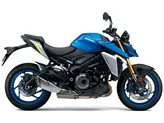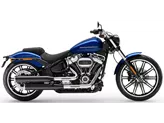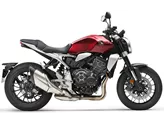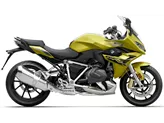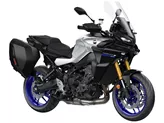Yamaha MT-09 2016 vs. Suzuki GSX-S1000 2018

Yamaha MT-09 2016

Suzuki GSX-S1000 2018
Pregled - Yamaha MT-09 2016 vs Suzuki GSX-S1000 2018
The Yamaha MT-09 2016 and the Suzuki GSX-S1000 2018 are both naked bikes that offer powerful performance and attractive features. However, there are some notable differences between the two models.
In terms of engine power, the Suzuki GSX-S1000 2018 has a clear advantage with 149 HP compared to the Yamaha MT-09 2016's 115 HP. This extra power can provide a more exhilarating riding experience and faster acceleration. Additionally, the Suzuki GSX-S1000 2018 has a higher torque of 106 Nm compared to the Yamaha MT-09 2016's 87.5 Nm, which can contribute to better low-end power and responsiveness.
Both bikes have in-line engines, but the Yamaha MT-09 2016 has a three-cylinder engine while the Suzuki GSX-S1000 2018 has a four-cylinder engine. The Yamaha's three-cylinder engine offers a unique and distinctive sound, while the Suzuki's four-cylinder engine provides a more traditional and sporty sound.
In terms of suspension, the Yamaha MT-09 2016 features a telescopic fork front suspension, while the Suzuki GSX-S1000 2018 has an upside-down telescopic fork front suspension. The upside-down fork on the Suzuki may provide better handling and stability, especially during aggressive riding.

Yamaha MT-09 2016
Both bikes have aluminum frames with a twin tube design, which helps to keep the weight down and improve handling. The Yamaha MT-09 2016 weighs 191 kg (with ABS) while the Suzuki GSX-S1000 2018 weighs 209 kg (with ABS). The lighter weight of the Yamaha may contribute to better maneuverability and agility.
In terms of braking, both bikes have double disk front brakes, providing strong and reliable stopping power. This is important for sporty riding and ensuring rider safety.
In terms of dimensions, both bikes have a front tire width of 120 mm and a front tire diameter of 17 inches. However, the Suzuki GSX-S1000 2018 has a wider rear tire width of 190 mm compared to the Yamaha MT-09 2016's 180 mm. This wider rear tire may provide better traction and stability during cornering.
The Yamaha MT-09 2016 has a wheelbase of 1440 mm, while the Suzuki GSX-S1000 2018 has a slightly longer wheelbase of 1460 mm. A longer wheelbase can contribute to better stability at higher speeds.
Both bikes have a seat height of 815 mm, providing a comfortable and upright riding position. This is ideal for long rides and reducing rider fatigue.

Suzuki GSX-S1000 2018
In terms of fuel tank capacity, the Suzuki GSX-S1000 2018 has a larger capacity of 17 liters compared to the Yamaha MT-09 2016's 14 liters. This larger fuel tank can provide a longer riding range, reducing the need for frequent refueling.
In terms of strengths, the Yamaha MT-09 2016 offers a wonderfully powerful three-cylinder powerplant, three power modes, a fully adjustable chassis, a quickshifter as standard, a sporty upright seating position, good brakes, aggressive looks, and traction control. On the other hand, the Suzuki GSX-S1000 2018 has stable handling that inspires confidence, a wonderfully sporty engine, a sexy look and sound, pleasant riding comfort, and a dynamic yet calm riding experience.
In terms of weaknesses, the Yamaha MT-09 2016 has a saddle that may be a little too hard for long tours and a license plate holder on the swingarm that offers less splash protection than a conventional one. The Suzuki GSX-S1000 2018 may be a little jerky when changing from push to load, and some riders may prefer a quickshifter with a blipper for smoother gear shifts.
Overall, both the Yamaha MT-09 2016 and the Suzuki GSX-S1000 2018 are impressive naked bikes with their own strengths and weaknesses. The choice between the two ultimately depends on the rider's preferences and priorities, whether it be power, handling, comfort, or aesthetics.
Tehničke specifikacije Yamaha MT-09 2016 u odnosu na Suzuki GSX-S1000 2018
Prednosti i nedostaci u odnosu na
Prednosti i nedostaci u odnosu na
Yamaha MT-09 2016

The Yamaha MT-09 did not need to be reinvented for the coming season - it already was extremely well done almost four years ago. Instead, the Japanese focus on fine-tuning and adding practical, contemporary gimmicks such as traction control and automatic shifting. Due to the Euro4 standard, however, the engine management has been changed once again and offers an emphatically powerful but well controllable power delivery in standard mode; the power explosion of the first generation is now no longer offered even by the sharper A mode. The biggest change, recognisable at first glance, is the, in my opinion, extremely successful design with the more aggressive front and the newly designed rear. All in all, an even snazzier naked bike that was clearly built for the fun of motorcycling.
Suzuki GSX-S1000 2018

The GSX-S 1000 from Suzuki looks sexy, has a powerful sound and really smart hardware. It rides stably, easily and is also fun to ride on tours. If necessary, the engine smokes up violently. But it can also be moved mildly. Compared to the finest Powernakeds, it lacks individual features, but anyone who looks at the price tag will quickly realise: A great choice!
Usporedba cijena Prosječna tržišna cijena Yamaha MT-09 vs Suzuki GSX-S1000
There are a few key differences between a Yamaha MT-09 2016 and a Suzuki GSX-S1000 2018. In terms of price, the actual average price of a Suzuki GSX-S1000 2018 is about 27% higher. A Yamaha MT-09 2016 experiences a loss of 420 USD in one year and 720 USD in two years of ownership. This is offset by a loss of 270 USD and 1,010 USD for a Suzuki GSX-S1000 2018. Compared to Suzuki GSX-S1000 2018 there are more Yamaha MT-09 2016 bikes available on the 1000PS.de Marketplace, specifically 11 compared to 9. It takes less time to sell a Yamaha MT-09 with 87 days compared to 177 days for a Suzuki GSX-S1000. Since model year 2013 1000PS.de editors have written 57 reviews for the Yamaha MT-09 and 36 reviews for the Suzuki GSX-S1000 since model year 2015. The first review for the Yamaha MT-09 was published on 6/10/2013 and now has more than 39,900 views. This compares to more than 17,100 views for the first review on Suzuki GSX-S1000 published on 9/27/2014.




